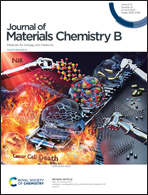Rational design of type-I photosensitizer molecules for mitochondrion-targeted photodynamic therapy†
Abstract
Photodynamic therapy (PDT) has emerged as a promising approach for tumor treatment. However, traditional type II PDT faces limitations due to its oxygen-dependent nature. Type-I photosensitizers (PSs) exhibit superiority over conventional type-II PSs owing to their diminished oxygen dependence. Nevertheless, designing effective type-I PSs remains a significant challenge. In this work, we provide a novel strategy to tune the PDT mechanism of an excited photosensitizer through aryl substituent engineering. Using S-rhodamine as the base structure, three PSs were synthesized by incorporating phenyl, furyl, or thienyl groups at the meso position. Interestingly, furyl- or thienyl-substituted S-rhodamine are type-I-dominated PSs that produce O2˙−, while phenyl S-rhodamine results in O2˙− and 1O2 through type-I and type-II mechanisms, respectively. Experimental analyses and theoretical calculations showed that the introduction of a five-membered heterocycle at the meso position promoted intersystem crossing (ISC) and electron transfer, facilitating the production of O2˙−. Furthermore, furyl- or thienyl-substituted S-rhodamine exhibited high phototoxicity at ultralow concentrations. Thienyl-substituted S-rhodamine showed promising PDT efficacy against hypoxic solid tumors. This innovative strategy provides an alternative approach to developing new type-I PSs without the necessity for creating entirely new skeletons.

- This article is part of the themed collection: 2024 Journal of Materials Chemistry B HOT Papers


 Please wait while we load your content...
Please wait while we load your content...